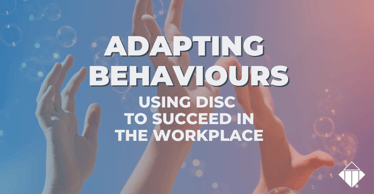DISC Profile in Leadership Development
Successful leadership relies on the ability to influence others' behaviour in order to accomplish an objective. The ability to influence others is greatly enhanced by training on a behavioural model. New to the DISC profile? Read an introduction here.
This article explores how you might use the DISC profile in leadership development training, which is one of the most common applications of DISC in the workplace.
DISC tends to be used as the basis of improving relationships and communication between managers and teams, and is often introduced in leadership development programs to serve as a language for understanding, identifying and adapting behavioural styles.
How to Introduce DISC to Leaders
In more than 20 years of seeing consultants, trainers, HR, Learning and OD professionals roll-out training, we have noticed that organisations have vastly different approaches to how they structure their leadership programs; that is, no two follow the same structure.
There is no single best way to coach, train or facilitate DISC, so what follows is simply a scripted example to help illustrate one way that DISC might be introduced to a group of leaders.

Facilitator: “Welcome to [Leadership 101]. One of the cornerstones of this training is human relationships. Since leadership is all about people — inspiring and guiding others towards a common vision — we’re going to look at how the way we communicate with others on a daily basis impacts our success or failure as leaders.
This program is not about spending the next 4 hours to work on improving your eloquence or charisma, nor is it about trying to mould you into any kind of specific leadership style. This training is simply about developing a clearer picture of what your natural communication style is and how you prefer to go about your work, versus how others with different styles prefer to behave and communicate, and what steps you can take in order to interact with others more effectively.
To help us achieve these goals, we’re going to explore something called the DISC profile, which is one of the most widespread professional development tools taken by millions of people every year and used by hundreds of thousands of companies around the world, including about 75% of the Fortune 500.
The thing that I think you’ll like most about this tool is that it is simple and practical — it's not some abstract university theory, and you won't need to have any kind of background in psychology.
From this training, you’ll benefit from more than 50 years of research that has proven that there are four types of basic behavioural preferences inherit in all people on earth. DISC has emerged as the most popular model for explaining these four behaviours as it gives its users simple and effective guidelines for building trust and cooperation, and reducing the potential for conflict and misunderstandings.
In essence, DISC is a framework that has simplified decades of research on how humans prefer to work, act, behave, socialise and communicate with each other, which we’re going to take advantage of and use to help accelerate our abilities to lead and manage the people around us.”
Following this introduction, the participants would then receive an overview of the four primary DISC behaviours, including what each factor stands for and the common characteristics, strengths and tendencies associated with each. For fun, you might wish to use these famous characters as examples.
The leaders should begin to learn what conditions each of the four styles respond to best, and how to adapt their preferred leadership style in order to communicate more effectively and get the best performance from each.
At this point, it is a good idea to present the leaders with their DISC profiles (or some specific parts of them) so that they can relate the DISC principles to their own situation. It's worthwhile to have all the leaders participate in activities and discussions that highlight important differences in their styles, which works best if there are people with opposite styles in the room.
Once the leaders have a grounded understanding of the research and principles of DISC, and once they have established an awareness of their own style and that of others, we might provide them with some strategies to put the DISC language into action with their teams.
This is where the DISC framework is so invaluable. The leaders can then go back to their workplace and share the information with their teams and use the DISC framework as a common language (or set of terms) to discuss their working preferences. Managers will learn to be more adaptive to their team, and team members learn to be more adaptive to each other and their manager.

Key Benefits of DISC Profiling & Training for Leaders & Their Teams
- Build Trust: Trust is the most valuable resource that a leader has. While there are many factors that will build or erode trust, the leader that recognises and responds to others' preferred method of communication and approach to work will be in a much better position to gain the cooperation and commitment of those around them.
- Better Communication: Understand the best (and worst) ways to communicate with each team member.
- Team Synergy: Team members will develop a better awareness of each others' communication and work style, as well as their manager's. By being able to predict other people's natural responses to situations, they can learn to more quickly adapt to the situation themselves.
- Self-Awareness: Help the leader understand how their behavioural tendencies might be perceived by others in the team (particularly those of the opposite style).
- Assign Tasks: Understand which people are better behaviourally suited to certain types of tasks.
- Prevent Conflict/Misunderstandings: The DISC model helps to reduce team conflict by providing a common language to discuss behavioural tendencies (which is particularly important to those with opposite styles).
- Team is Better with Customers/Selling: Customers buy from people they like and trust. With a guiding awareness of their own tendencies and that of others, team members will be able to more effectively communicate, build rapport, and present information according to the customer's unique buying style.
- Hiring/Induction: The DISC profile can be used to highlight potential behavioural strengths and possible challenges which can then be addressed and targeted with questions in the interview stage. The DISC profile should ultimately validate or challenge the hiring manager's impression of the candidate, and be used to determine if there is an apparent mis-match between the role and the candidate's natural behaviour. It is also a useful on-boarding/induction tool so that the manager and the rest of the team have a clearer picture about what they can expect from the new recruit and how they prefer to go about their work.
- Coaching Tool: The DISC profile serves as a platform to have non-threatening conversations about people's behaviours (particularly non-productive behaviours).
- Feedback is Validated: Team members will more readily accept negative feedback from a computerised assessment about their behaviours than they would if they were to hear the same feedback from their manager or another individual.
- Improve Emotional Intelligence (EI): The ultimate goal of the DISC profile (along with all other similar professional development tools) is to improve the individual's emotional intelligence. Because the DISC profile is very simple and practical, it is one of the best frameworks available for fast-tracking EI, particularly in the domains of Empathy and Social Skills.

Trevor O'Sullivan
General Manager. Since the early 2000s, Trevor has worked with thousands of Talent Management professionals to develop and apply assessment-based talent management solutions for selecting, developing and managing people. Trevor is an active member of the TTI Success Insights (TTISI) Global Advisory Council, contributes to TTISI product development and is a regular presenter at TTISI-R3. He is honoured to have received multiple Blue Diamond Awards and, more recently, the Bill Brooks Impact Award recognising his contributions to the TTISI global network.

![12 Ways to Identify Behavioural Styles Through Casual Observation [Infographic] | Infographic](https://blog.ttisuccessinsights.com.au/hs-fs/hubfs/TTISI%20Blog%20Images%20%28Canva%29/12%20Ways%20to%20Identify%20Behavioral%20Styles%20Through%20Casual%20Observation%20%5BInfographic%5D.png?width=374&name=12%20Ways%20to%20Identify%20Behavioral%20Styles%20Through%20Casual%20Observation%20%5BInfographic%5D.png)


0 Comments